Occlusal pads of a clasp denture
Machine translation
Original article is written in RU language (link to read it) .
Occlusal overlays are structural elements of a clasp denture, the main task of which is to distribute the vertical load from the base of the denture itself to the supporting teeth. It is customary to divide the supporting teeth into the following types:
- terminal,
- intermediate,
- limiting the defect.
Learn more about the laboratory stages of creating removable dentures in the webinar Laboratory stages of manufacturing removable dentures.
On the teeth, occlusal overlays are predominantly placed together with clasps, this single structure has been named a supporting-retaining clasp. However, considering that the vertical load significantly exceeds the horizontal load, occlusal overlays have been distinguished as an independent structural element, which differs functionally from the clasp.
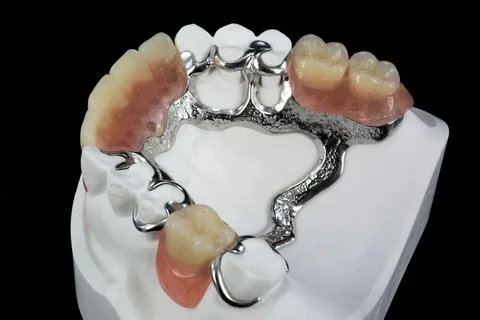
Figure 1. Occlusal overlays in the structure of a clasp denture.
In some situations, the overlays are located independently of the clasps, mostly on adjacent teeth. Then the supporting teeth participate in performing different tasks: some resist vertical load, others counteract the force that tries to overturn the denture from the jaw or shift it horizontally.
The following functions of occlusal overlays can be highlighted:
- they reduce the immersion of the denture body into the thickness of the mucosa, preventing compression of the gum adjacent to the supporting teeth;
- along with the clasp body, they serve to prevent food penetration between the support and the base of the clasp;
- they prevent vertical displacement of the clasp arm, responsible for retention and stabilization of the clasp.
The installation of occlusal overlays is carried out in such a way as not to interfere with the normal occlusion of the dental arches. In cases of a small occlusal gap for placing the overlay, the tooth is specially prepared. Such preparation of the support involves grinding the occlusal and proximal walls of the crown of the supporting tooth towards the base. A depression is formed on the occlusal surface in the thickness of the enamel, its configuration replicates the shape of a spoon. The ground enamel surface is carefully polished and coated with fluoride-containing agents.
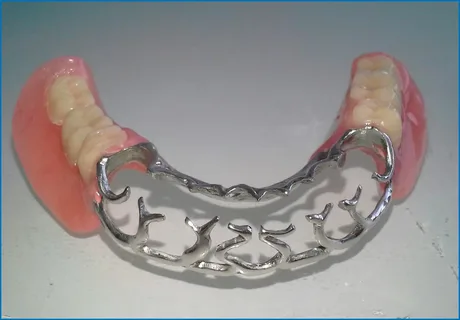
Figure 2. Clasp denture.
The angle formed by the body of the clasp and the occlusal overlay should be slightly rounded; it should not be excessively thinned as this may cause it to fracture. Ideally, the width of the overlay should be one-third of the tooth's width (about three millimeters). To prevent deformation, the overlay is made of a certain thickness. Overlays made from durable cobalt-chrome alloy can be made thinner, whereas overlays from soft platinum and gold alloys will be 1.5 times thicker. This is a clear advantage of using non-precious alloys, as it requires less depth of grinding on the surfaces of the supporting teeth crowns.
If a patient clinically exhibits a reduction in bite height, deep incisal overlap, or low crowns, preference is given to a special type of overlays that cover the occlusal surface between the peaks of all cusps. These overlays are called "onlays". They are used to restore contacts of tilted teeth, correct interalveolar height. Combining such overlays with plastic helps optimize aesthetic qualities and achieve a tight intercuspal contact with opposing teeth.
If an occlusal overlay is placed on the surface of the front teeth on the side of the oral cavity, it is possible to achieve the buccal displacement of these teeth. To prevent such displacement, the bed is formed at the cusps of the teeth in the shape of V-shaped steps.
Classification of Occlusal Overlays
It is customary to distinguish occlusal overlays for anterior teeth and for chewing teeth. Also, occlusal overlays are divided into single-sided and double-sided.
Single-sided overlays are further divided into the following subgroups, determined by their length:
- Short, their length does not exceed half of the occlusal surface.
- Medium, occupy half of the occlusal surface.
- Long, located on most of the chewing surface.
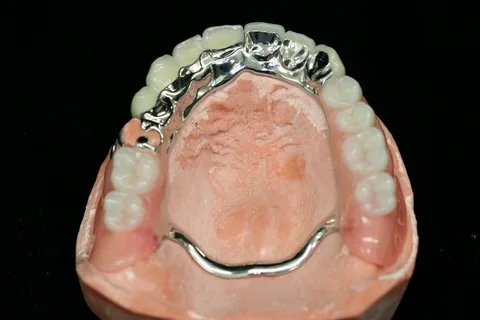
Figure 3. Use of occlusal overlays.
Additionally, frontal overlays are divided into single and multi-link. Single overlays are subdivided into the following types:
- oral overlay, designed for canines;
- double-arm support;
- medial overlay, is a structural element of the Svenson clasp;
- oral arm – is an overlay, the design of which is equipped with vestibular captures.
- An oral overlay is used on the front teeth. It is placed on the distal surface of the crown from the side of the oral cavity, and it is the most popular type of supporting device in the front section.
- A double-arm rest. Equipped with two short arms. It is predominantly used on the distal surface of the canines in cases of minor included defects, where it is aesthetically preferable not to use a clasp.
- Medial overlay. Used when there is slight mobility of the canine, if it serves as the supporting tooth in Kennedy class I, allowing the tooth to tilt towards the adjacent teeth.
- Arm-overlay. Used when preserving single-standing front teeth, which are used to create stabilization and support for the clasp, and also for splinting teeth that have slight mobility.
Multi-link overlays come in the following types:
- narrow;
- medium;
- extended.
They are used to optimize the stabilization of the clasp and to redistribute the load on the remaining teeth. The primary function of these constructions is not to fix the prosthesis, but to transfer the load, hence the name - overlays. All listed support elements can easily be combined with retentive embrasure hooks if it is necessary to splint teeth with slight mobility.
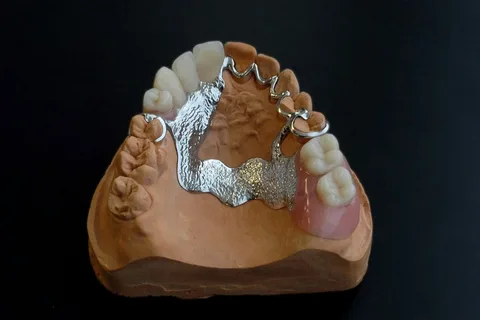
Figure 4. Combined clasp denture.
Narrow multi-link overlays are localized over the tubercles for circular stabilization.
Medium overlays are placed up to the cervical area, with the gingival edge free from contact. Used to increase interalveolar height, recreating contact between the front teeth of both jaws.
Extended overlays are placed up to the mucosal ridge on the lower jaw or palatal grooves. Indicated in cases of torus, when there is a lack of space for the lower arch, or instead of multi-link overlays, lingual and anterior palatal arches in the denture design. Such constructions are often referred to as metal plates.
Multi-link overlays are used to solve a number of tasks:
- support;
- indirect fixation;
- in the transverse plane – stabilization.
Contraindications for the use of multi-link overlays:
- lack of space on the front teeth of the upper jaw when teeth are closed;
- front teeth have an oral tilt;
- support teeth have low clinical crowns;
- there are diastemas and tremas, which may be accompanied by the transparency of metal, accumulation of food residues.
Several multi-link overlays (six or more links) need to be reinforced by increasing the cross-section or using additional crossbars at the canines on the lower jaw, and on the upper jaw – flat branching of bases. If there is tooth mobility, embrasure hooks for splinting are placed between adjacent teeth in the created gaps.
Preparation of teeth with tremas requires less volume. Embrasure hooks from multi-link overlays branch off towards the cutting edge, are thrown over to the vestibular surface through the interdental embrasures, and their approach to the guiding line is not permissible. They solve the task of support, prevent anteroposterior movement, rotation of the clasp around its own axis, prevent the denture base from deepening into the mucosa, ensure splinting of teeth with mobility, stabilize the clasp, redistribute chewing pressure on the remaining teeth. Embrasure hooks distribute the vertical load along the axis of the fixed teeth.
The combination of embrasure hooks with occlusal pads serves as a prevention of the archwire moving towards the gum. It is necessary to ensure that the hooks do not limit the closure of the teeth, nor disrupt the occlusal plane.
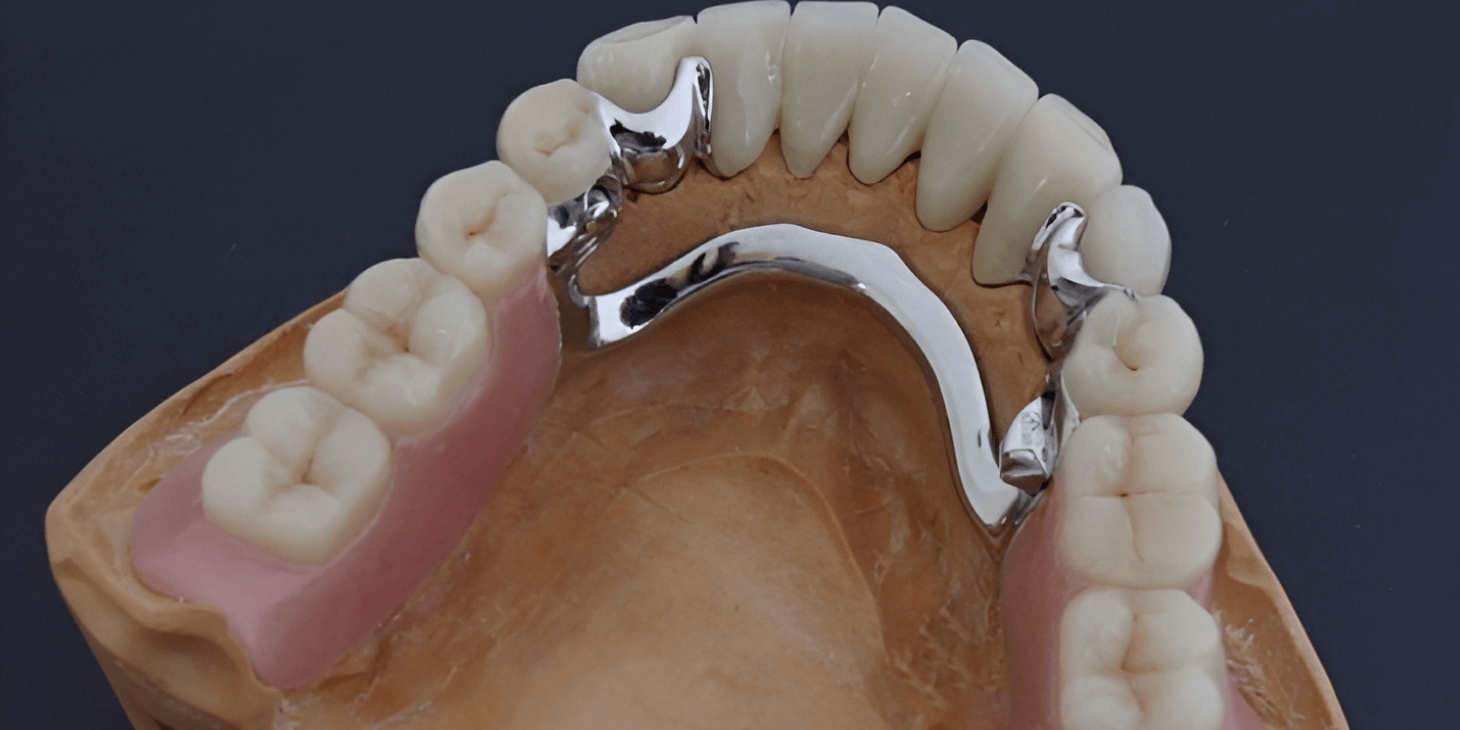
Figure 5. Occlusal overlays in the design of a clasp denture.
If all anterior teeth are mobile, splinting is ineffective, as the assembly of teeth with a metal structure will be unstable. Blocking can be used if there is stabilization of the splint, against the background of creating a planar arrangement of clasps, when lines drawn through the supporting teeth form a polygon.
The shoulder-overlay, equipped with vestibular embrasure hooks, distributes the chewing load along the longitudinal axis of the support. The shoulder-overlay also connects the included saddles into a single clasp denture system.
For more current information on this topic, visit the webinar Introduction to Removable Prosthodontics.

/public-service/media/default/572/EZZ73_688b148d1b19f.jpg)
/public-service/media/default/575/suWYa_688b15a42ab5b.jpg)
/public-service/media/default/573/wsedP_688b14f5d4ae9.jpg)
/public-service/media/default/509/Uf8w4_671f5e937c60e.png)